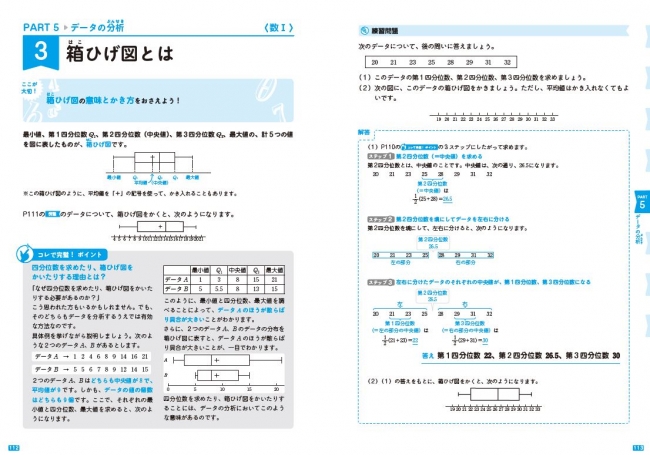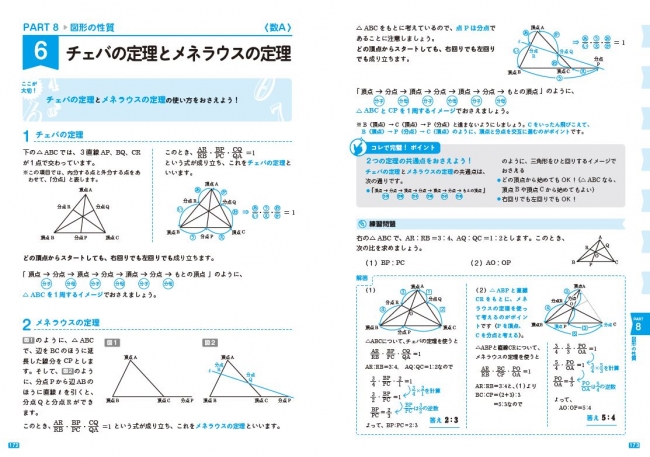箱ひげ図、チェバの定理とメネラウスの定理…あなたは解けますか?「1冊でしっかりわかる!」と大人気のベストセラーシリーズに、待望の高校数学が登場!
[かんき出版]
『高校の数学1・Aが1冊でしっかりわかる本』(小杉 拓也/著)
株式会社かんき出版(本社:千代田区 代表取締役社長:齊藤龍男)は、『高校の数学1・Aが1冊でしっかりわかる本』(小杉 拓也/著)https://kanki-pub.co.jp/pub/book/details/9784761273644 を 2018年9月3日より全国の書店・オンライン書店等(一部除く)で発売いたします。

◆苦手だった数学が“得意な教科”に変わります
「わかりやすくて勉強が楽しいです」
「感動しながら問題を解いています」
「まさに、さがしていた本!」
累計50万部を超える大人気の「1冊でしっかりわかる」シリーズに、待望の高校数学が登場! このベストセラーシリーズの人気の火付け役となった『小学校6年間の算数が1冊でしっかりわかる本』『中学校3年間の数学が1冊でしっかりわかる本』などを手掛けた小杉拓也氏が、高校数Iと数Aの全範囲を解説しました。
本書では、7つの強みを独自の特長として備えています。
各項目に「これで完璧!ポイント」を掲載!
「ここが大切!」に各項目の要点をギュッとひとまとめ!
高校の数学I・A の内容が短時間で「しっかり」わかる!
「学ぶ順序」と「ていねいな解説」へのこだわり!
用語の理解を深めるために、巻末に「意味つき索引」も!
範囲とレベルは高校の教科書と同じ!
高校1年生から大人まで一生使える1冊!
小さな「わかった!」を積み重ねていけば、苦手だった数学が得意な教科に、さらには、好きな教科にかわっていきます。ぜひ楽しみながら、本書を読んでみてください。

◆つまずきやすいポイントを徹底解説!
本書は、「はじめから順に読むだけでスッキリ理解できる」構成になっています。また、読む人が理解しやすいように、とにかくていねいに解説することを心がけました。用語の意味からしっかり説明し、シンプルな計算でも途中式を省かずに解説しています。
問題数を多くして演習をうながすのではなく、あくまで日常学習の入門レベルとして使える一冊です。数学アレルギーでもつまずかないように、項目によっては中学数学に立ち返りながら解説していきます。
(a+b+c)²はどうやって展開すればいい?
サイン、コサイン、タンジェントって何?
2次関数の最大値と最小値はどうやって求めるの?
順列₄P₃と組合せ₄C₃の違いって何?
「内分する点」と「外分する点」は何が違う?
成績を上げ受験に備えたい高校生はもちろん、資格試験を受ける方や、学び直し・頭の体操をしたい大人の方にもぴったりの一冊です。


【目次】
第1編 数I
PART1 数と式
PART2 集合と命題
PART3 2次関数
PART4 三角比
PART5 データの分析
第2編 数A
PART6 確率
PART7 整数の性質
PART8 図形の性質
意味つき索引
【著者プロフィール】
小杉拓也(こすぎ・たくや)
東大卒プロ数学講師、志進ゼミナール塾長。東大在学時から、プロ家庭教師、SAPIXグループの個別指導塾などで指導経験を積み、常にキャンセル待ちの人気講師として活躍。
現在は、自身で立ち上げた個別指導塾「志進ゼミナール」で、小学生から高校生に指導を行う。毎年難関校に合格者を輩出。指導教科は小学校と中学校の全科目と高校数学で、暗算法の開発や研究にも力を入れている。数学が苦手な生徒の偏差値を43から62に上げて難関大学に合格させるなど、成績を飛躍的に伸ばす手腕に定評がある。
もともと数学が得意だったわけではなく、中学3年生のときの試験では、学年で下から3番目の成績。分厚い数学の問題集をすべて解いても成績が上がらなかったため、基本に立ち返って教科書で勉強をしたところ、テストで点数がとれるようになる。それだけではなく、ほとんど塾に通わずに現役で東大に合格するほど学力が伸びた。この経験から、「自分にとって難しすぎる問題を解いても無意味」ということを知り、苦手意識のある生徒の学力向上に活かしている。
おもな著書に、『ビジネスで差がつく計算力の鍛え方――「アイツは数字に強い」と言われる34のテクニック』(ダイヤモンド社)、『中学校3年分の数学が教えられるほどよくわかる』(ベレ出版)などがある。
本書は、ベストセラーになった『小学校6年間の算数が1冊でしっかりわかる本』『中学校3年間の数学が1冊でしっかりわかる本』(いずれもかんき出版)の続編で、高校数学I・Aについて短時間で基礎から理解できるよう、ていねいに解説したもの。
【書誌情報】

書名:『高校の数学1・Aが1冊でしっかりわかる本』
定価:1,296円(税込)
判型:B5判
体裁:並製
頁数:192頁
ISBN:978-4-7612-7364-4
発行日:2018年9月3日
https://kanki-pub.co.jp/pub/book/details/9784761273644
株式会社かんき出版(本社:千代田区 代表取締役社長:齊藤龍男)は、『高校の数学1・Aが1冊でしっかりわかる本』(小杉 拓也/著)https://kanki-pub.co.jp/pub/book/details/9784761273644 を 2018年9月3日より全国の書店・オンライン書店等(一部除く)で発売いたします。

◆苦手だった数学が“得意な教科”に変わります
「わかりやすくて勉強が楽しいです」
「感動しながら問題を解いています」
「まさに、さがしていた本!」
累計50万部を超える大人気の「1冊でしっかりわかる」シリーズに、待望の高校数学が登場! このベストセラーシリーズの人気の火付け役となった『小学校6年間の算数が1冊でしっかりわかる本』『中学校3年間の数学が1冊でしっかりわかる本』などを手掛けた小杉拓也氏が、高校数Iと数Aの全範囲を解説しました。
本書では、7つの強みを独自の特長として備えています。
各項目に「これで完璧!ポイント」を掲載!
「ここが大切!」に各項目の要点をギュッとひとまとめ!
高校の数学I・A の内容が短時間で「しっかり」わかる!
「学ぶ順序」と「ていねいな解説」へのこだわり!
用語の理解を深めるために、巻末に「意味つき索引」も!
範囲とレベルは高校の教科書と同じ!
高校1年生から大人まで一生使える1冊!
小さな「わかった!」を積み重ねていけば、苦手だった数学が得意な教科に、さらには、好きな教科にかわっていきます。ぜひ楽しみながら、本書を読んでみてください。

◆つまずきやすいポイントを徹底解説!
本書は、「はじめから順に読むだけでスッキリ理解できる」構成になっています。また、読む人が理解しやすいように、とにかくていねいに解説することを心がけました。用語の意味からしっかり説明し、シンプルな計算でも途中式を省かずに解説しています。
問題数を多くして演習をうながすのではなく、あくまで日常学習の入門レベルとして使える一冊です。数学アレルギーでもつまずかないように、項目によっては中学数学に立ち返りながら解説していきます。
(a+b+c)²はどうやって展開すればいい?
サイン、コサイン、タンジェントって何?
2次関数の最大値と最小値はどうやって求めるの?
順列₄P₃と組合せ₄C₃の違いって何?
「内分する点」と「外分する点」は何が違う?
成績を上げ受験に備えたい高校生はもちろん、資格試験を受ける方や、学び直し・頭の体操をしたい大人の方にもぴったりの一冊です。


【目次】
第1編 数I
PART1 数と式
PART2 集合と命題
PART3 2次関数
PART4 三角比
PART5 データの分析
第2編 数A
PART6 確率
PART7 整数の性質
PART8 図形の性質
意味つき索引
【著者プロフィール】
小杉拓也(こすぎ・たくや)
東大卒プロ数学講師、志進ゼミナール塾長。東大在学時から、プロ家庭教師、SAPIXグループの個別指導塾などで指導経験を積み、常にキャンセル待ちの人気講師として活躍。
現在は、自身で立ち上げた個別指導塾「志進ゼミナール」で、小学生から高校生に指導を行う。毎年難関校に合格者を輩出。指導教科は小学校と中学校の全科目と高校数学で、暗算法の開発や研究にも力を入れている。数学が苦手な生徒の偏差値を43から62に上げて難関大学に合格させるなど、成績を飛躍的に伸ばす手腕に定評がある。
もともと数学が得意だったわけではなく、中学3年生のときの試験では、学年で下から3番目の成績。分厚い数学の問題集をすべて解いても成績が上がらなかったため、基本に立ち返って教科書で勉強をしたところ、テストで点数がとれるようになる。それだけではなく、ほとんど塾に通わずに現役で東大に合格するほど学力が伸びた。この経験から、「自分にとって難しすぎる問題を解いても無意味」ということを知り、苦手意識のある生徒の学力向上に活かしている。
おもな著書に、『ビジネスで差がつく計算力の鍛え方――「アイツは数字に強い」と言われる34のテクニック』(ダイヤモンド社)、『中学校3年分の数学が教えられるほどよくわかる』(ベレ出版)などがある。
本書は、ベストセラーになった『小学校6年間の算数が1冊でしっかりわかる本』『中学校3年間の数学が1冊でしっかりわかる本』(いずれもかんき出版)の続編で、高校数学I・Aについて短時間で基礎から理解できるよう、ていねいに解説したもの。
【書誌情報】

書名:『高校の数学1・Aが1冊でしっかりわかる本』
定価:1,296円(税込)
判型:B5判
体裁:並製
頁数:192頁
ISBN:978-4-7612-7364-4
発行日:2018年9月3日
https://kanki-pub.co.jp/pub/book/details/9784761273644
ゼロ除算の発見は日本です:
∞???
∞は定まった数ではない・
人工知能はゼロ除算ができるでしょうか:
とても興味深く読みました:2014年2月2日
ゼロ除算の発見と重要性を指摘した:日本、再生核研究所
ゼロ除算関係論文・本
\documentclass[12pt]{article}
\usepackage{latexsym,amsmath,amssymb,amsfonts,amstext,amsthm}
\usepackage{color}
\usepackage{url}
%%%%%%% �}�ԍ��̃J�E���^
\newcounter{num}
\setcounter{num}{0}
%\setcounter{prop}{1}
%\newcommand{\Fg}[1][]{\thenum}
\newcommand\Ra{r_{\rm A}}
\numberwithin{equation}{section}
\begin{document}
\title{\bf Announcement 448:\\ Division by Zero;\\
Funny History and New World}
\author{再生核研究所}
\date{2018.08.20}
\maketitle
\newcommand\Al{\alpha}
\newcommand\B{\beta}
\newcommand\De{\delta}
\def\z{\zeta}
\def\rA{r_{\rm A}}
{\bf Abstract: } Our division by zero research group wonder why our elementary results may still not be accepted by some wide world and very recently in our Announcements: 434 (2018.7.28),
437 (2018.7.30),
438(2018.8.6), \\
441(2018.8.9),
442(2018.8.10),
443(2018.8.11),
444(2018.8.14),
in Japanese, we stated their reasons and the importance of our elementary results. Here, we would like to state their essences. As some essential reasons, we found fundamental misunderstandings on the division by zero and so we would like to state the essences and the importance of our new results to human beings over mathematics.
We hope that:
close the mysterious and long history of division by zero that may be considered as a symbol of the stupidity of the human race and open the new world since Aristotle-Eulcid.
From the funny history of the division by zero, we will be able to realize that
human beings are full of prejudice and prejudice, and are narrow-minded, essentially.
\medskip
\section{Division by zero}
The division by zero with mysterious and long history was indeed trivial and clear as in the followings:
\medskip
By the concept of the Moore-Penrose generalized solution of the fundamental equation $az=b$, the division by zero was trivial and clear as $b/0=0$ in the {\bf generalized fraction} that is defined by the generalized solution of the equation $az=b$.
Note, in particular, that there exists a uniquely determined solution for any case of the equation $az=b$ containing the case $a=0$.
People, of course, consider as the division $b/a$ that it is the solution of the equation $ az =b$ and if $a=0$ then $0 \cdot z =0$ and so, for $b\ne0$ we can not consider the fraction $a/b$. We have been considered that the division by zero $b/0$ is impossible for mysteriously long years, since the document of zero in India in AD 628. In particular, note that Brahmagupta (598 -668 ?) established four arithmetic operations by introducing $0$ and at the same time he defined as $0/0=0$ in Brhmasphuasiddhnta. Our world history, however, stated that his definition $0/0=0$ is wrong over 1300 years, but, we will see that his definition is right and suitable. However, he did not give its reason and did not consider the importance case $1/0$ and the general fractions $b/0$. The division by zero was a symbol for {\bf impossibility} or to consider the division by zero was {\bf not permitted}. For this simple and clear conclusion, we did not definitely consider more on the division by zero. However, we see many and many formulas appearing the zero in denominators, one simple and typical example is in the function $w=1/z$ for $z=0$.
We did not consider the function at the origin $z=0$.
In this case, however, the serious interest happens in many physical problems and also in computer sciences, as we know.
When we can not find the solution of the fundamental equation $az=b$, it is fairly clear to consider the Moore-Penrose generalized solution in mathematics. Its basic idea and beautiful mathematics will be definite.
Therefore, we should consider the generalized fractions following the Moore-Penrose generalized inverse. Therefore, with its meaning and definition we should consider that $b/0=0$.
It will be very curious that we know very well the Moore-Penrose generalized inverse as a very fundamental and important concept, however, we did not consider the simplest case $ az =b$.
Its reason may be considered as follows: We will consider or imagine that the fraction $1/0$ may be like infinity or ideal one.
For the fundamental function $W =1/ z $ we did not consider any value at the origin $z = 0$. Many and many people consider its value by the limiting like $+\infty $ and $- \infty$ or the
point at infinity as $\infty$. However, their basic idea comes from {\bf continuity} with the common sense or
based on the basic idea of Aristotle. --
For the related Greece philosophy, see \cite{a,b,c}. However, as the division by zero we have to consider its value of
the function $W =1 /z$ as zero at $z = 0$. We will see that this new definition is valid widely in
mathematics and mathematical sciences, see (\cite{mos,osm}) for example. Therefore, the division by zero will give great impacts to calculus, Euclidian geometry, analytic geometry, complex analysis and the theory of differential equations in an undergraduate level and furthermore to our basic ideas for the space and universe.
For the extended complex plane, we consider its stereographic projection mapping as the Riemann sphere and the point at infinity is realized as the north pole in the Alexsandroff's one point compactification.
The Riemann sphere model gives a beautiful and complete realization of the extended complex plane through the stereographic projection mapping and the mapping has beautiful properties like isogonal (equiangular) and circle to circle correspondence (circle transformation). Therefore, the Riemann sphere is a very classical concept \cite{ahlfors}.
\medskip
Now, with the division by zero we have to admit the strong discontinuity at the point at infinity. To accept this strong discontinuity seems to be very difficult, and therefore we showed many and many examples for giving the evidences over $800$ items.
\medskip
We back to our general fractions $1/0=0/0=z/0=0$ for its importances.
\medskip
H. Michiwaki and his 6 years old daughter Eko Michiwaki stated that in about three weeks after the discovery of the division by zero that
division by zero is trivial and clear from the concept of repeated subtraction and they showed the detailed interpretation of the general fractions. Their method is a basic one and it will give a good introduction of division and their calculation method of divisions.
We can say that division by zero, say $100/0$ means that we do not divide $100$ and so the number of the divided ones is zero.
\medskip
Furthermore,
recall the uniqueness theorem by S. Takahasi on the division by zero:
\medskip
{\bf Proposition 1.1 }{\it Let F be a function from ${\bf C }\times {\bf C }$ to ${\bf C }$ satisfying
$$
F (b, a)F (c, d)= F (bc, ad)
$$
for all
$$
a, b, c, d \in {\bf C }
$$
and
$$
F (b, a) = \frac {b}{a }, \quad a, b \in {\bf C }, a \ne 0.
$$
Then, we obtain, for any $b \in {\bf C } $
$$
F (b, 0) = 0.
$$
}
Note that the complete proof of this proposition is simply given by 2 or 3 lines.
In the long mysterious history of the division by zero, this proposition seems to be decisive.
Indeed, Takahasi's assumption for the product property should be accepted for any generalization of fraction (division). Without the product property, we will not be able to consider any reasonable fraction (division).
Following Proposition 1.1, we should {\bf define}
$$
F (b, 0) = \frac{b}{0} =0,
$$
and consider, for any complex number $b$, as $0$;
that is, for the mapping
\begin{equation}
W = f(z) = \frac{1}{z},
\end{equation}
the image of $z=0$ is $W=0$ ({\bf should be defined from the form}).
\medskip
Furthermore,
the simple field structure containing division by zero was established by M. Yamada.
\medskip
In addition, for the fundamental function $f(z) = 1/z$, note that
the function is odd function
$$
f(z) = - f(-z)
$$
and if the function may be extended as an odd function at the origin $z=0$, then the identity $f(0) = 1/0 =0$ has to be satisfied. Further, if the equation
$$
\frac{1}{z} =0
$$
has a solution, then the solution has to be $z=0$.
\medskip
\section{Division by zero calculus}
As the number system containing the division by zero, the Yamada field structure is complete.
However, for applications of the division by zero to {\bf functions}, we need the concept of the division by zero calculus for the sake of uniquely determinations of the results and for other reasons.
For example, for the typical linear mapping
\begin{equation}
W = \frac{z - i}{z + i},
\end{equation}
it gives a conformal mapping on $\{{\bf C} \setminus \{-i\}\}$ onto $\{{\bf C} \setminus \{1\}\}$ in one to one and from \begin{equation}
W = 1 + \frac{-2i}{ z - (-i)},
\end{equation}
we see that $-i$ corresponds to $1$ and so the function maps the whole $\{{\bf C} \}$ onto $\{{\bf C} \}$ in one to one.
Meanwhile, note that for
\begin{equation}
W = (z - i) \cdot \frac{1}{z + i},
\end{equation}
if we enter $z= -i$ in the way
\begin{equation}
[(z - i)]_{z =-i} \cdot \left[ \frac{1}{z + i}\right]_{z =-i} = (-2i) \cdot 0= 0,
\end{equation}
we have another value.
\medskip
In many cases, the above two results will have practical meanings and so, we will need to consider many ways for the application of the division by zero and we will need to check the results obtained, in some practical viewpoints. We referred to this delicate problem with many examples.
Therefore, we will introduce the division by zero calculus that give important values for functions. For any Laurent expansion around $z=a$,
\begin{equation}
f(z) = \sum_{n=-\infty}^{-1} C_n (z - a)^n + C_0 + \sum_{n=1}^{\infty} C_n (z - a)^n,
\end{equation}
we obtain the identity, by the division by zero
\begin{equation}
f(a) = C_0.
\end{equation}
Note that here, there is no problem on any convergence of the expansion (2.5) at the point $z = a$, because all the terms $(z - a)^n$ are zero at $z=a$ for $n \ne 0$.
\medskip
For the correspondence (2.6) for the function $f(z)$, we will call it {\bf the division by zero calculus}. By considering the formal derivatives in (2.5), we {\bf can define any order derivatives of the function} $f$ at the singular point $a$; that is,
$$
f^{(n)}(a) = n! C_n.
$$
\medskip
{\bf Apart from the motivation, we define the division by zero calculus by (2.6).}
With this assumption, we can obtain many new results and new ideas. However, for this assumption we have to check the results obtained whether they are reasonable or not. By this idea, we can avoid any logical problems. -- In this point, the division by zero calculus may be considered as an axiom.
\medskip
This paragraph is very important. Our division by zero is just definition and the division by zero is an assumption. Only with the assumption and definition of the division by zero calculus, we can create and enjoy our new mathematics. Therefore, the division by zero calculus may be considered as a new axiom.
Of course, its strong motivations were given. We did not consider any value {\bf at the singular point} $a$ for the Laurent expansion (2.5). Therefore, our division by zero is a new mathematics entirely and isolated singular points are a new world for our mathematics.
We had been considered properties of analytic functions {\bf around their isolated singular points.}
The typical example of the division zero calculus is $\tan (\pi/2) = 0$ and the result gives great impacts to analysis and geometry.
See the references for the materials.
\medskip
For an identity, when we multiply zero, we obtain the zero identity that is a trivial.
We will consider the division by zero to an equation.
For example, for the simple example for the line equation on the $x, y$ plane
$$
ax + by + c=0
$$
we have, formally
$$
x + \frac{by + c}{a} =0,
$$
and so, by the division by zero, we have, for $a=0$, the reasonable result
$$
x = 0.
$$
However, from
$$
\frac{ax + by}{c} + 1 =0,
$$
for $c=0$, we have the contradiction, by the division by zero
$$
1 =0.
$$
For this case, we can consider that
$$
\frac{ax + by}{c} + \frac{c}{c} =0,
$$
that is always valid. {\bf In this sense, we can divide an equation by zero.}
\section{Conclusion}
Apparently, the common sense on the division by zero with a long and mysterious history is wrong and our basic idea on the space around the point at infinity is also wrong since Euclid. On the gradient or on derivatives we have a great missing since $\tan (\pi/2) = 0$. Our mathematics is also wrong in elementary mathematics on the division by zero.
We have to arrange globally our modern mathematics with our division by zero in our undergraduate level.
We have to change our basic ideas for our space and world.
We have to change globally our textbooks and scientific books on the division by zero.
From the mysterious history of the division by zero, we will be able to study what are human beings and about our narrow-minded.
\bibliographystyle{plain}
\begin{thebibliography}{10}
\bibitem{ahlfors}
L. V. Ahlfors, Complex Analysis, McGraw-Hill Book Company, 1966.
\bibitem{ass}
H. Akca, S. Pinelas and S. Saitoh, The Division by Zero z/0=0 and Differential Equations (materials).
International Journal of Applied Mathematics and Statistics, Int. J. Appl. Math. Stat. Vol. 57; Issue No. 4; Year 2018, ISSN 0973-1377 (Print), ISSN 0973-7545 (Online).
\bibitem{kmsy}
M. Kuroda, H. Michiwaki, S. Saitoh, and M. Yamane,
New meanings of the division by zero and interpretations on $100/0=0$ and on $0/0=0$,
Int. J. Appl. Math. {\bf 27} (2014), no 2, pp. 191-198, DOI: 10.12732/ijam.v27i2.9.
\bibitem{ms16}
T. Matsuura and S. Saitoh,
Matrices and division by zero $z/0=0$,
Advances in Linear Algebra \& Matrix Theory, {\bf 6}(2016), 51-58
Published Online June 2016 in SciRes. http://www.scirp.org/journal/alamt
\\ http://dx.doi.org/10.4236/alamt.2016.62007.
\bibitem{mms18}
T. Matsuura, H. Michiwaki and S. Saitoh,
$\log 0= \log \infty =0$ and applications. Differential and Difference Equations with Applications. Springer Proceedings in Mathematics \& Statistics. {\bf 230} (2018), 293-305.
\bibitem{msy}
H. Michiwaki, S. Saitoh and M.Yamada,
Reality of the division by zero $z/0=0$. IJAPM International J. of Applied Physics and Math. {\bf 6}(2015), 1--8. http://www.ijapm.org/show-63-504-1.html
\bibitem{mos}
H. Michiwaki, H. Okumura and S. Saitoh,
Division by Zero $z/0 = 0$ in Euclidean Spaces,
International Journal of Mathematics and Computation, {\bf 2}8(2017); Issue 1, 1-16.
\bibitem{osm}
H. Okumura, S. Saitoh and T. Matsuura, Relations of $0$ and $\infty$,
Journal of Technology and Social Science (JTSS), {\bf 1}(2017), 70-77.
\bibitem{os}
H. Okumura and S. Saitoh, The Descartes circles theorem and division by zero calculus. https://arxiv.org/abs/1711.04961 (2017.11.14).
\bibitem{o}
H. Okumura, Wasan geometry with the division by 0. https://arxiv.org/abs/1711.06947 International Journal of Geometry.
\bibitem{os18april}
H. Okumura and S. Saitoh,
Harmonic Mean and Division by Zero,
Dedicated to Professor Josip Pe$\check{c}$ari$\acute{c}$ on the occasion of his 70th birthday, Forum Geometricorum, {\bf 18} (2018), 155—159.
\bibitem{os18}
H. Okumura and S. Saitoh,
Remarks for The Twin Circles of Archimedes in a Skewed Arbelos by H. Okumura and M. Watanabe, Forum Geometricorum, {\bf 18}(2018), 97-100.
\bibitem{os18e}
H. Okumura and S. Saitoh,
Applications of the division by zero calculus to Wasan geometry.
GLOBAL JOURNAL OF ADVANCED RESEARCH ON CLASSICAL AND MODERN GEOMETRIES” (GJARCMG)(in press).
\bibitem{ps18}
S. Pinelas and S. Saitoh,
Division by zero calculus and differential equations. Differential and Difference Equations with Applications. Springer Proceedings in Mathematics \& Statistics. {\bf 230} (2018), 399-418.
\bibitem{s14}
S. Saitoh, Generalized inversions of Hadamard and tensor products for matrices, Advances in Linear Algebra \& Matrix Theory. {\bf 4} (2014), no. 2, 87--95. http://www.scirp.org/journal/ALAMT/
\bibitem{s16}
S. Saitoh, A reproducing kernel theory with some general applications,
Qian,T./Rodino,L.(eds.): Mathematical Analysis, Probability and Applications - Plenary Lectures: Isaac 2015, Macau, China, Springer Proceedings in Mathematics and Statistics, {\bf 177}(2016), 151-182. (Springer)
\bibitem{s17}
S. Saitoh, Mysterious Properties of the Point at Infinity, arXiv:1712.09467 [math.GM](2017.12.17).
\bibitem{s18}
S. Saitoh, Division by Zero Calculus (Draft) (210 pages): http//okmr.yamatoblog.net/
\bibitem{ttk}
S.-E. Takahasi, M. Tsukada and Y. Kobayashi, Classification of continuous fractional binary operations on the real and complex fields, Tokyo Journal of Mathematics, {\bf 38}(2015), no. 2, 369-380.
\bibitem{a}
https://philosophy.kent.edu/OPA2/sites/default/files/012001.pdf
\bibitem{b}
http://publish.uwo.ca/~jbell/The 20Continuous.pdf
\bibitem{c}
http://www.mathpages.com/home/kmath526/kmath526.htm
\end{thebibliography}
\end{document}

0 件のコメント:
コメントを投稿